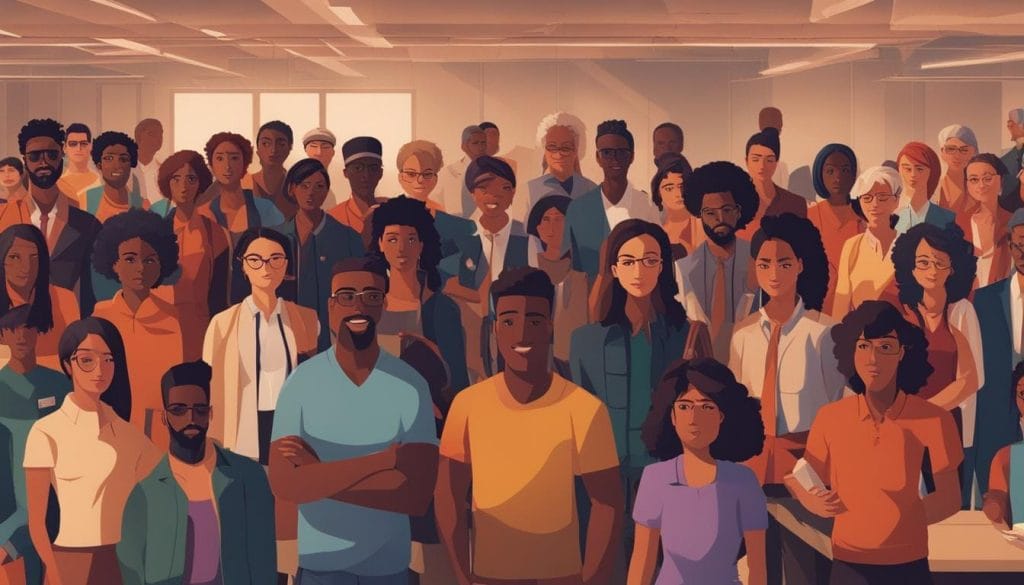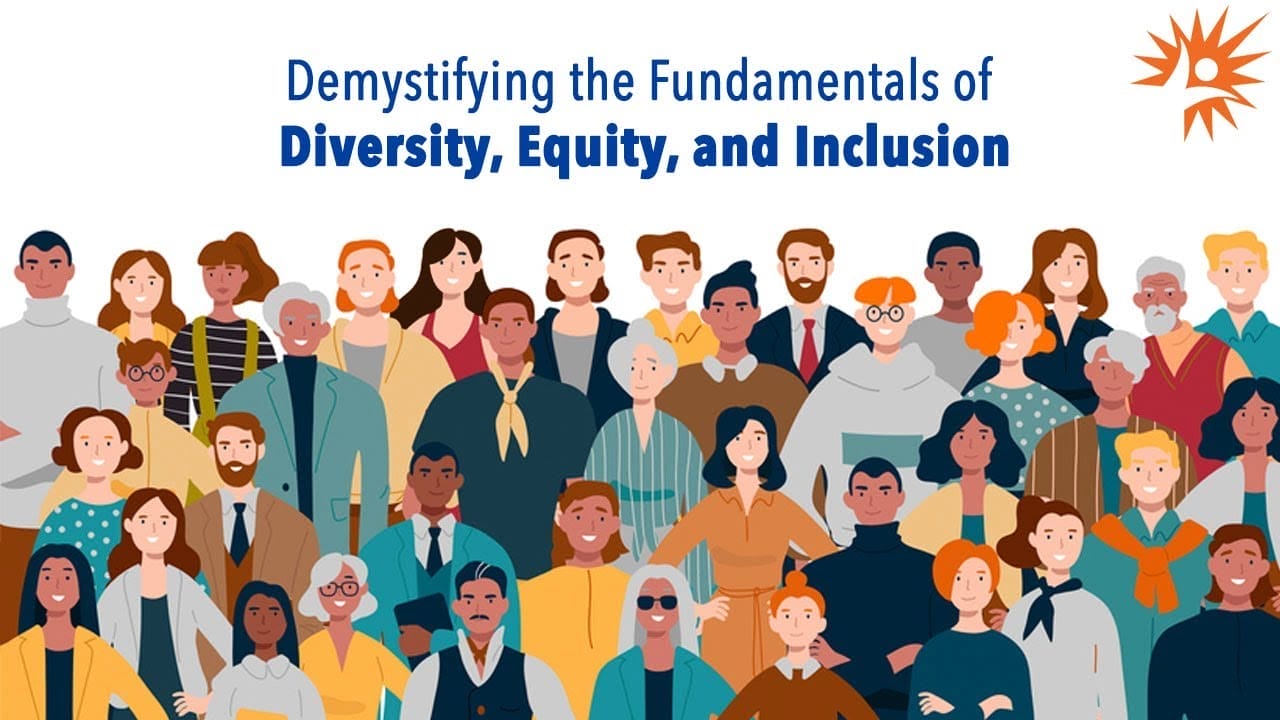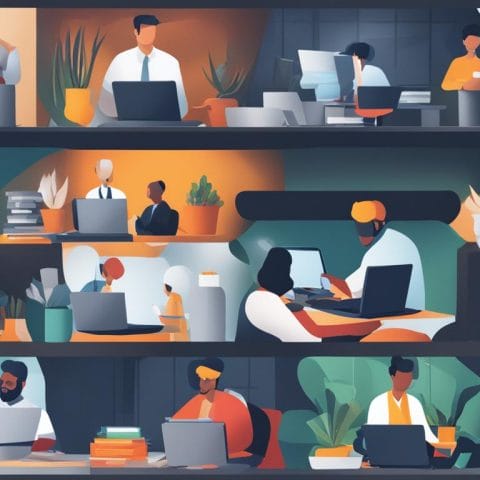In today’s diverse and rapidly changing work environments, organizations are increasingly recognizing the importance of diversity and inclusion training. Did you know that organizations with inclusive cultures are 6 times more likely to be innovative and agile? This statistic highlights the significant impact that diversity training can have on creating a thriving and inclusive workplace culture.
Diversity training topics cover a wide range of areas, from generational diversity to intentional inclusion, microaggressions, racism, and stereotypes. By addressing these topics through targeted training programs, organizations can foster understanding, empathy, and respect among employees, ultimately creating a more harmonious and productive work environment.
Key Takeaways:
- Workplace diversity seminars and training activities play a crucial role in fostering inclusivity and equity.
- Generational diversity training helps bridge the gap between different age groups in the workforce, reducing stereotypes and misunderstandings.
- Intentional inclusion emphasizes purposeful action to create a culture of diversity and inclusivity in the workplace.
- Microaggressions training helps employees recognize and address subtle acts of discrimination that can harm morale and productivity.
- Diversity training encompasses both diversity and inclusion, with diversity focusing on representation and inclusion promoting a sense of belonging.
Generational Diversity in the Workplace
Generational diversity is a fundamental aspect that organizations need to address in their diversity training programs. With a workforce consisting of different generations, such as Generation X, Millennials, and Generation Z, it is crucial to bridge the gap and foster understanding among employees from varying age groups. Training on generational diversity enables organizations to create a harmonious and productive multigenerational workforce.
Generational diversity training offers several benefits to companies striving for a diverse and inclusive workplace culture. By promoting understanding and collaboration between different generations, organizations can break down stereotypes, reduce misunderstandings, and improve overall productivity. It provides a platform for employees to learn from one another’s experiences, perspectives, and skill sets.
“Generational diversity training helps organizations to harness the strengths and unique qualities of each generation. It allows for generational collaboration, enabling innovative problem-solving and the exchange of knowledge and skills. By creating an environment that values the contributions of all age groups, companies can leverage the diverse perspectives of their multigenerational workforce.”
– Jane Williams, HR Manager at XYZ Corporation
Generational diversity training addresses a variety of topics, including understanding generational characteristics, communication styles, and work expectations. It promotes open dialogue, empathy, and respect among employees of different age groups, enhancing teamwork and collaboration.
One effective approach in generational diversity training is to conduct interactive workshops and group discussions. These activities provide opportunities for employees to share their experiences, challenge assumptions, and learn from one another. By fostering a culture of open communication, organizations can build a stronger and more inclusive workforce.
Generational Diversity Training Table
| Generational Diversity Topics | Training Objectives |
|---|---|
| Understanding generational characteristics and values | Develop empathy and respect for different generations |
| Effective communication across generations | Promote clear and constructive communication |
| Managing generational conflicts | Resolve conflicts and build cohesive teams |
| Recognizing generational strengths | Identify and leverage each generation’s unique skills |
| Promoting generational collaboration | Foster teamwork and knowledge sharing |
Generational diversity training equips employees with the knowledge and skills necessary to navigate the complexities of working in a multigenerational workforce. By embracing generational diversity, organizations can create an inclusive environment that values each employee’s contribution, enhances employee morale, and drives organizational success.
Intentional Inclusion

Intentional inclusion is a critical aspect of fostering a diverse and inclusive workplace culture. It goes beyond passive acceptance and encourages purposeful action-based plans to create an environment where all employees feel valued, respected, and included.
An inclusive workplace culture is essential for organizations to thrive and succeed in today’s global and diverse workforce. It not only promotes diversity, but also cultivates an environment where individuals from different backgrounds, experiences, and perspectives can collaborate effectively, innovate, and contribute to the organization’s growth.
Implementing diversity and inclusion initiatives requires intentional efforts from every employee. It is not solely the responsibility of the HR department or management, but a collective effort from individuals at all levels of the organization. Each employee plays a crucial role in actively contributing to creating a culture of inclusion and cultural awareness.
Fostering Inclusion Through Diversity and Inclusion Initiatives
Diversity and inclusion initiatives are strategic actions taken by organizations to foster intentional inclusion in the workplace. These initiatives can encompass a range of activities, programs, and policies that aim to create a more inclusive work environment.
Examples of diversity and inclusion initiatives include:
- Forming employee resource groups (ERGs) to provide support and networking opportunities for underrepresented groups.
- Implementing unconscious bias training programs to help employees recognize and address their unconscious biases.
- Providing mentorship and sponsorship programs to support the career development of diverse talent.
- Creating inclusive recruitment and hiring practices to attract and retain a diverse workforce.
- Establishing diversity metrics and goals to track progress and hold leadership accountable.
These initiatives create a framework for intentional inclusion, empowering employees to challenge biases, celebrate diversity, and amplify underrepresented voices.
“Intentional inclusion is not an option, but a necessity for organizations that value diversity and want to create an inclusive workplace culture.” – Laura Rodriguez, Chief Diversity Officer at XYZ Company
Training on intentional inclusion plays a crucial role in educating employees about the importance of diversity and inclusion, as well as their role in promoting these values within the organization. It equips employees with the knowledge, skills, and tools to create an inclusive workspace where everyone feels welcome, respected, and empowered to contribute their unique perspectives.
Microaggressions at Work
Microaggressions are subtle acts of discrimination that can often go unnoticed in the workplace, but they have a significant impact on morale and productivity. They can create a hostile work environment and undermine efforts to foster diversity and inclusion. It is crucial for organizations to address microaggressions through targeted training programs that raise awareness and empower employees to spot and stop these harmful behaviors.
Spotting Microaggressions
Recognizing microaggressions requires understanding the different forms they can take. They can be verbal, such as comments that perpetuate stereotypes or marginalize certain groups. Non-verbal microaggressions can include body language, gestures, or tone of voice that convey subtle biases. Environmental microaggressions involve creating an exclusionary atmosphere, such as displaying offensive imagery or excluding certain individuals from conversations or opportunities.
Here are examples of different types of microaggressions in the workplace:
- A manager consistently mispronouncing a colleague’s name or making jokes about their accent, subtly implying that their cultural background is inferior.
- Colleagues assuming that a woman in a leadership position must have gotten there because of quotas or diversity initiatives, implying that her competence is in question.
- Excluding a team member from important meetings or social activities based on their sexual orientation or gender identity, isolating them and reinforcing prejudices.
Stopping Microaggressions
Stopping microaggressions requires proactive efforts from both individuals and organizations. Training programs can equip employees with the skills and knowledge to address microaggressions effectively. Through inclusive workshops, discussions, and case studies, employees gain a deeper understanding of the impact of microaggressions and learn strategies to respond appropriately.
Some effective strategies for stopping microaggressions include:
- Active listening and empathy: Validating the experiences of individuals who have been targeted by microaggressions and demonstrating support can help create a safe environment for them to speak up.
- Interrupting and educating: Taking immediate action when witnessing a microaggression by respectfully addressing the issue and educating the person responsible about the impact of their words or actions.
- Creating accountability: Encouraging reporting mechanisms and establishing consequences for those who engage in repeated microaggressions sends a clear message that such behavior will not be tolerated.
“Microaggressions can be harmful and perpetuate inequality in the workplace. By fostering a culture that values and respects diversity, organizations can create an environment where microaggressions are less likely to occur.”
By actively addressing microaggressions, organizations can cultivate a workplace culture that supports the well-being and success of all employees, regardless of their background or identity. Building awareness and providing the necessary tools to spot and stop microaggressions helps create a working environment where everyone feels valued, respected, and included.
| Impact of Microaggressions | Examples | Consequences |
|---|---|---|
| Lower morale and job satisfaction | A manager consistently interrupting or dismissing ideas from a specific employee during meetings | Decreased motivation, disengagement, and reduced productivity |
| Impaired professional relationships and teamwork | Colleagues making jokes or comments about a team member’s religious beliefs | Friction, distrust, and lack of collaboration |
| Negative impact on mental health | Criticizing the appearance or clothing choices of a co-worker based on cultural stereotypes | Anxiety, stress, and decreased overall well-being |
Creating a workplace environment free from microaggressions is essential for building a diverse and inclusive organization. By addressing these issues head-on, organizations can foster a culture of respect, equity, and collaboration where employees thrive and contribute their full potential.
Diversity vs. Inclusion

When it comes to fostering a diverse and inclusive workplace culture, it is crucial to understand the distinction between diversity and inclusion. While both concepts are interconnected, they focus on different aspects of creating a harmonious and productive work environment.
Diversity refers to the representation and variety of different identities within an organization. This includes factors such as age, gender, race, ethnicity, sexual orientation, and more. A diverse workplace embraces individuals from various backgrounds and perspectives, recognizing the value they bring to the table.
Inclusion, on the other hand, revolves around creating an environment where everyone feels valued, accepted, and included. It goes beyond mere representation and focuses on fostering a sense of belonging. In an inclusive workplace, individuals are given equal opportunities and resources, and their contributions are acknowledged and respected.
To cultivate a truly diverse and inclusive workplace, organizations need to prioritize both diversity and inclusion. Diversity lays the foundation for representing a wide range of perspectives, experiences, and talents. Inclusion, however, ensures that these diverse voices are heard, valued, and empowered.
Training on diversity and inclusion plays a pivotal role in achieving these goals. It helps employees understand the significance of embracing diversity and creating an inclusive work culture. Through education and awareness, individuals gain the knowledge and skills necessary to foster an environment that is welcoming, respectful, and supportive of all.
“Diversity is being invited to the party; inclusion is being asked to dance.” – Verna Myers
Benefits of Diversity and Inclusion in the Workplace
By prioritizing diversity and inclusion, organizations can reap numerous benefits:
- Increased Innovation: A diverse and inclusive workplace brings together individuals with unique perspectives and experiences. This diversity of thought fosters creativity and innovation, enabling organizations to stay agile and competitive in a rapidly changing world.
- Enhanced Problem-solving: When diverse minds come together, they offer a broader range of solutions and insights to complex challenges. Inclusive environments encourage collaboration and open dialogue, leading to more effective problem-solving.
- Better Employee Engagement: When employees feel included and valued, they are more likely to be engaged and committed to their work. This increased engagement leads to higher productivity and job satisfaction.
- Improved Talent Attraction and Retention: Organizations that prioritize diversity and inclusion become more attractive to top talent. Individuals seek out workplaces where they feel accepted and can thrive, resulting in higher employee retention rates.
Creating a diverse and inclusive workplace requires ongoing commitment from all levels of an organization. It involves actively seeking diverse talent, implementing inclusive policies and practices, and providing training and support to foster a culture of acceptance and respect for all.
| Diversity | Inclusion |
|---|---|
| Represents the variety of different identities | Creates an environment where everyone feels valued and included |
| Fosters broader perspectives and experiences | Encourages collaboration and equal participation |
| Brings innovation and creativity | Enhances problem-solving capabilities |
| Reflects the demographics of society | Promotes a culture of acceptance and respect |
Racism
With the increasing focus on racial and social justice, companies must prioritize anti-racism training as a crucial component of their diversity initiatives. By implementing comprehensive training on racism, organizations can educate employees about the harmful impacts of racism and equip them with the knowledge and skills needed to create an inclusive and equal workplace environment.
Racism holds no place in a diverse and inclusive workplace. It perpetuates systemic inequalities and prevents individuals from reaching their full potential. Through anti-racism training, organizations can foster an environment where all employees feel valued, respected, and empowered to contribute their unique perspectives and experiences.
Anti-racism training goes beyond simply acknowledging the existence of racism; it entails actively challenging and combating racist attitudes, behaviors, and practices. Training sessions provide employees with the tools to recognize and address unconscious biases, microaggressions, and discriminatory practices that may perpetuate racism within the workplace.
The goal of anti-racism training is not only to raise awareness about racism but also to empower individuals to take action. This involves cultivating empathy, empathy *and understanding for others’ experiences, *empowering employees to speak up against racism, and promoting allyship and solidarity. Organizations that take a proactive stance against racism demonstrate their commitment to creating an inclusive and equitable workplace culture.
By integrating anti-racism training into their diversity and inclusion initiatives, companies can drive positive change, not only within their own organizations, but also in society as a whole. Training programs can serve as a catalyst for meaningful dialogue and reflection, fostering an environment where employees can collectively work towards dismantling systemic barriers and promoting social justice.
“Anti-racism is not an option; it is a necessity. Organizations have a responsibility to address racism head-on and create an environment that is truly inclusive for everyone.”
Benefits of Anti-Racism Training
Implementing anti-racism training in the workplace offers numerous benefits for both organizations and individuals. Here are some key advantages:
- Promotes a Culture of Inclusivity: Anti-racism training contributes to the development of an inclusive workplace culture where diverse perspectives are valued and respected.
- Reduces Bias and Discrimination: By increasing awareness of unconscious biases and providing strategies to overcome them, anti-racism training helps mitigate discriminatory practices.
- Enhances Collaboration and Productivity: When employees feel safe and supported, they are more likely to collaborate effectively and contribute to increased productivity.
- Attracts and Retains Talent: Organizations that prioritize diversity and inclusion, including anti-racism training, are more likely to attract and retain top talent from diverse backgrounds.
- Positive Reputation: Taking a proactive approach to combat racism enhances an organization’s reputation as an inclusive and socially responsible employer.
Embedding Anti-Racism Training in Organizational Practices
Creating an inclusive and anti-racist workplace requires more than just one-time training sessions. Organizations should integrate anti-racism principles into their policies, procedures, and everyday practices. This includes:
- Leadership Commitment: Leaders should demonstrate their commitment to anti-racism by setting clear expectations and holding themselves and others accountable for promoting an inclusive environment.
- Regular Training and Education: Ongoing training and education on anti-racism ensure that employees stay informed and updated on best practices.
- Establishing Employee Resource Groups: Employee resource groups provide a platform for employees to share experiences, offer support, and collaborate on anti-racism initiatives.
- Reviewing Policies and Procedures: Organizations should regularly review and update their policies to identify and address any systemic biases that may contribute to racism or discrimination.
By taking a comprehensive approach to anti-racism training and embedding its principles throughout the organization, companies can create a lasting impact and work towards a truly equitable and inclusive workplace.
For more information on the importance of anti-racism training in creating an inclusive workplace, refer to this article.
Culture Diversity
Cultural diversity is a paramount aspect of creating a harmonious and productive work environment. Embracing cultural diversity in the workplace fosters inclusivity and reduces conflicts among employees. Cross-cultural training plays a pivotal role in helping employees understand and appreciate different cultural backgrounds, facilitating effective communication and collaboration.
By providing cross-cultural training, organizations equip their workforce with the knowledge and skills necessary to navigate cultural differences. This training promotes cultural awareness, sensitivity, and respect within the workplace, resulting in an inclusive and cohesive work culture. Employees learn to value diverse perspectives, unlocking creativity and innovation that enhance overall productivity.
Developing an inclusive workplace culture means acknowledging and celebrating the unique contributions each individual brings to the table. In an inclusive workplace, diverse cultural backgrounds are seen as strengths rather than barriers. This not only enriches the work experience for employees but also leads to improved customer relationships and business growth.
The Benefits of Cultural Diversity in the Workplace
Cultural diversity in the workplace brings forth numerous benefits:
- Promotes innovation and creativity through diverse perspectives
- Enhances problem-solving and decision-making abilities
- Increases employee engagement and satisfaction
- Improves customer relations and global reach
- Boosts profitability and competitiveness
Creating an Inclusive Workplace Culture
Fostering an inclusive workplace culture begins with leadership commitment. It involves establishing policies and practices that prioritize diversity, providing cross-cultural training opportunities, and fostering open dialogue around cultural differences. Organizations should also encourage employee resource groups and affinity networks to support individuals from various cultural backgrounds.
“A diverse and inclusive workplace culture empowers individuals to express their authentic selves, contributing to a sense of belonging and increased productivity. By embracing cultural diversity, organizations create a vibrant and inspiring work environment that nurtures growth and success.”
By embracing cultural diversity and implementing cross-cultural training programs, organizations can create a workplace where every employee feels valued, respected, and included. This inclusive environment fosters collaboration, creativity, and empathy, leading to improved organizational performance and a competitive edge in today’s diverse global market.
Stereotypes
Stereotypes can be harmful in the workplace, leading to conflict, low morale, and hindering progress. They are preconceived notions or generalizations about certain groups of people based on their characteristics, such as gender, race, age, or nationality. Challenging stereotypes is an important aspect of diversity training that helps create a more inclusive and respectful work environment.
By challenging stereotypes, organizations can encourage employees to recognize and overcome their biases. This training allows individuals to break free from assumptions and prejudices, fostering a culture that promotes diversity and inclusion. Challenging stereotypes empowers employees to appreciate the unique strengths and abilities of individuals regardless of their background or identity.
One effective way to challenge stereotypes is through education and awareness. Providing employees with information about different cultures, backgrounds, and experiences can help debunk common stereotypes. It encourages individuals to question their own biases and develop a deeper understanding of diversity and inclusion.
“Stereotypes are a reflection of our own biases and limited perspectives. Challenging them opens doors to new opportunities, fresh perspectives, and a more inclusive workplace.” – Maya Thompson, Diversity and Inclusion Consultant
The Impact of Challenging Stereotypes
Challenging stereotypes in the workplace has several positive impacts:
- Promoting diversity: By challenging stereotypes, organizations actively promote diversity and create a work environment that celebrates the uniqueness of each individual.
- Inclusive work culture: Challenging stereotypes fosters an inclusive work culture where everyone feels valued and respected, irrespective of their background.
- Reduced bias: Challenging stereotypes helps employees recognize and confront their own biases, leading to reduced discriminatory behaviors and attitudes.
- Enhanced teamwork: When stereotypes are challenged, employees are more likely to collaborate effectively and appreciate the contributions of diverse team members.
- Innovation and creativity: By embracing diverse perspectives and challenging stereotypes, organizations create an environment conducive to innovation and creativity.
Challenging stereotypes is an ongoing process that requires continuous education, open dialogue, and self-reflection. Initiating diversity training programs and workshops that address stereotypes directly can equip employees with the knowledge and skills needed to challenge biases and foster inclusivity in the workplace.
To create a more inclusive and respectful work environment, organizations should prioritize diversity training that specifically focuses on challenging stereotypes. By doing so, they can create a workplace where individuals feel empowered, appreciated, and valued for their unique qualities.
LGBTQ+ Diversity

LGBTQ+ diversity training is essential in fostering an inclusive workplace culture that values and respects individuals of all sexual orientations. This training equips employees with an understanding of sexual orientation, gender identity, and gender expression. By promoting LGBTQ+ inclusion, organizations demonstrate their commitment to diversity and equality.
Understanding LGBTQ+ Diversity
LGBTQ+ diversity training encourages employees to develop a comprehensive understanding of sexual orientation, gender identity, and gender expression. It educates individuals about the diverse experiences and challenges faced by LGBTQ+ individuals in both personal and professional settings.
This training goes beyond simply acknowledging the existence of LGBTQ+ individuals. It provides insights into the unique needs, concerns, and perspectives of the LGBTQ+ community, fostering a more empathetic and inclusive work environment.
Sexual Orientation Training
Sexual orientation training is a crucial component of LGBTQ+ diversity training. It aims to enhance awareness and knowledge of different sexual orientations, such as lesbian, gay, bisexual, and queer. This training educates participants about the importance of respecting and supporting diverse sexual orientations in the workplace.
Through sexual orientation training, employees can develop a deeper understanding of the challenges faced by individuals with various sexual orientations. This knowledge promotes empathy, reduces biases, and fosters a workplace culture that values and appreciates individuals regardless of their sexual orientation.
Gender Identity and Expression
Gender identity and expression training plays a significant role in LGBTQ+ diversity training. It focuses on understanding and respecting diverse gender identities beyond traditional binary concepts of male and female.
This training introduces participants to gender nonconformity, transgender identities, and the importance of using appropriate pronouns. It helps employees create an inclusive and respectful environment where individuals can express their gender identities authentically without fear of discrimination or prejudice.
Creating an Inclusive Work Environment
LGBTQ+ diversity training ultimately contributes to the creation of an inclusive work environment where all employees feel safe, supported, and valued. By promoting awareness, understanding, and acceptance of LGBTQ+ individuals, organizations demonstrate their commitment to diversity, equality, and a culture of respect.
| BENEFITS OF LGBTQ+ DIVERSITY TRAINING |
|---|
| Enhanced awareness and knowledge of LGBTQ+ issues |
| Reduced biases and increased empathy |
| Improved workplace inclusivity and employee morale |
| Increased productivity and collaboration |
| Attraction and retention of diverse talent |
Unconscious Bias
Unconscious bias refers to the attitudes or stereotypes that affect our understanding, actions, and decisions in an unconscious manner. These biases are deeply ingrained in our subconscious and can influence how we perceive and interact with others.
Bias training is a crucial component of diversity and inclusion initiatives in the workplace. It aims to raise awareness about unconscious biases and provide employees with the tools and strategies to recognize and manage them effectively.
By addressing unconscious biases, organizations can create a more inclusive and unbiased work environment, where individuals are evaluated based on their merits and not preconceived notions. This, in turn, allows for better decision-making, improved teamwork, and increased innovation.
Managing biases requires ongoing effort and a commitment to personal growth and development. Effective bias training programs often include a combination of education, self-reflection exercises, and interactive discussions to help individuals challenge their assumptions and broaden their perspectives.
Individuals who undergo bias training gain a deeper appreciation for diversity and learn to embrace different perspectives, which leads to a more collaborative and harmonious work environment. Organizations that invest in bias training demonstrate their commitment to creating an inclusive workplace culture and valuing the contributions of every employee.
By implementing bias training programs, organizations can minimize the negative impact of unconscious biases and create a workplace where diversity is celebrated, and everyone can thrive.
Benefits of Bias Training
Bias training offers several key benefits for organizations:
- Increased awareness: Bias training raises awareness about unconscious biases, helping employees recognize and challenge their own biases.
- Improved decision-making: By managing biases, employees can make more objective and fair decisions, free from the influence of unconscious prejudices.
- Enhanced teamwork: Bias training promotes inclusive behaviors and fosters better collaboration among team members, leading to improved teamwork and productivity.
- Reduced conflicts: By addressing biases, organizations can minimize conflicts arising from misunderstandings or discriminatory behavior.
- Business growth: An inclusive work environment attracts and retains diverse talent, which fuels innovation, creativity, and business success.
In conclusion, unconscious biases can hinder diversity and equality in the workplace. Bias training is essential for organizations to address these biases, foster inclusivity, and create a workplace where every individual feels valued and respected.
Conclusion
Diversity training topics are essential for organizations looking to create an inclusive and equitable work environment. By addressing various aspects such as generational diversity, intentional inclusion, and combating stereotypes, organizations can foster a diverse and inclusive workplace culture. This culture emphasizes the importance of diversity and inclusion to create a harmonious and productive work environment where every individual feels valued and respected.
Training on topics like racism, cultural diversity, LGBTQ+ inclusion, and unconscious bias plays a crucial role in creating a welcoming and inclusive workplace. These trainings help employees understand the impact of biases and discriminatory behaviors, enabling them to challenge and overcome these barriers. By promoting diversity training, organizations demonstrate their commitment to fostering an inclusive workplace culture.
To learn more about the importance of diversity, equity, and inclusion in the IT workforce, you can refer to the conclusion and recommendations provided by EDUCAUSE. These insights can further guide organizations in implementing effective diversity training programs and initiatives that promote an inclusive workplace culture.
FAQ
What are some essential diversity training topics for workplaces?
Some essential diversity training topics for workplaces include generational diversity, intentional inclusion, microaggressions, diversity vs. inclusion, racism, cultural diversity, stereotypes, LGBTQ+ diversity, unconscious bias, and more. These topics address various aspects of creating a diverse and inclusive work environment.
Why is generational diversity an important topic for diversity training?
Generational diversity is important for diversity training as it helps bridge the gap between different generations in the workforce. Training in generational diversity can prevent stereotypes and misunderstandings, leading to improved productivity and collaboration among employees of different generations.
What is intentional inclusion?
Intentional inclusion is a topic in diversity training that focuses on purposeful action-based plans to foster diversity and inclusion in the workplace. It emphasizes the need for all employees to actively contribute to creating a culture of inclusion and cultural awareness.
What are microaggressions, and why are they important to address in diversity training?
Microaggressions are subtle acts of discrimination that can be verbal, non-verbal, or environmental. They can have a significant impact on morale and productivity in the workplace. It is important to address microaggressions in diversity training to help employees recognize and address these harmful behaviors, fostering a more respectful and inclusive work environment.
What is the difference between diversity and inclusion in the workplace?
Diversity refers to the representation and variety of different identities in the workplace, while inclusion focuses on creating an environment where everyone feels valued and included. Diversity training topics often highlight the importance of both concepts and how they contribute to a positive work culture.
Why is training on racism important in diversity initiatives?
Training on racism is important in diversity initiatives to help employees understand the impact of racism and promote inclusivity and equality in the workplace. Addressing racism fosters a supportive and innovative work environment where all employees feel valued and respected.
What is the significance of cultural diversity training in the workplace?
Cultural diversity training is essential to create a harmonious and productive work environment. It helps employees understand and appreciate different cultural backgrounds, promoting inclusivity and reducing conflicts. Training on cultural diversity improves communication and collaboration among employees from various cultural backgrounds.
Why should stereotypes be challenged in diversity training?
Stereotypes can lead to conflict, low morale, and hinder progress in the workplace. Training on challenging stereotypes helps employees recognize and overcome their biases, creating a more inclusive and respectful work environment. By challenging stereotypes, organizations can leverage the strengths of individuals and foster a culture of diversity and inclusion.
Why is LGBTQ+ diversity training important for inclusive workplaces?
LGBTQ+ diversity training is crucial in creating an inclusive workplace where individuals of all sexual orientations feel valued and respected. The training helps employees understand the differences between sexual orientation, gender identity, and gender expression. By promoting LGBTQ+ inclusion, organizations demonstrate their commitment to diversity and equality.
Why should unconscious biases be addressed in diversity training?
Unconscious biases can hinder diversity and equality in the workplace. Training on unconscious bias helps employees identify and manage their biases, fostering a more inclusive and unbiased work environment. By addressing unconscious biases, organizations can unlock the full potential of their diverse workforce.
How do diversity training topics contribute to creating an inclusive workplace culture?
Diversity training topics play a vital role in creating inclusive and equitable work environments. By addressing various aspects such as generational diversity, intentional inclusion, combating stereotypes, and addressing biases, organizations can foster a diverse and inclusive workplace culture. Training on topics like racism, cultural diversity, LGBTQ+ inclusion, and unconscious bias helps create a welcoming and inclusive environment where all employees feel valued and respected.





